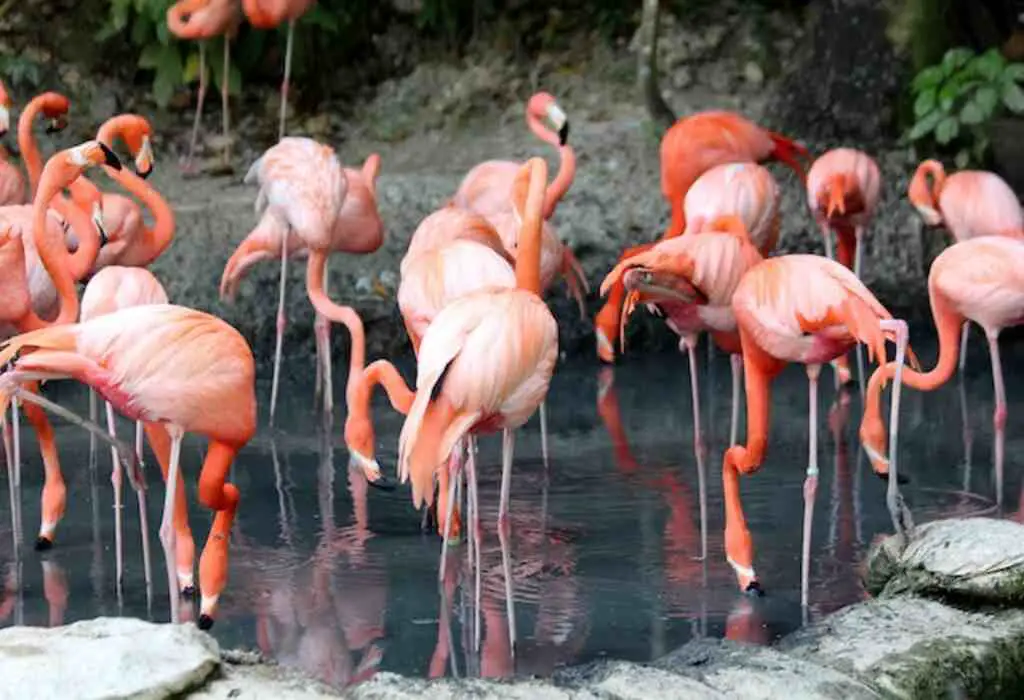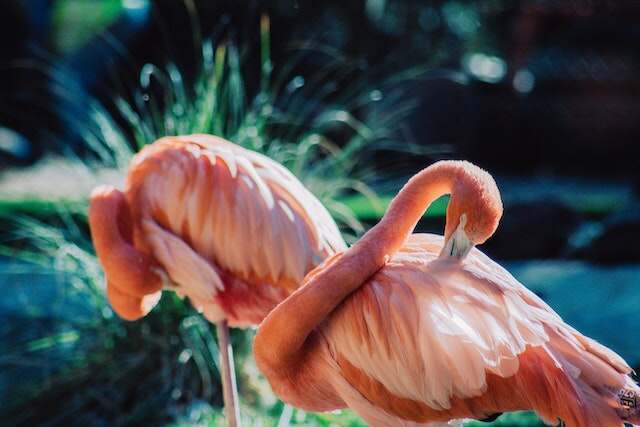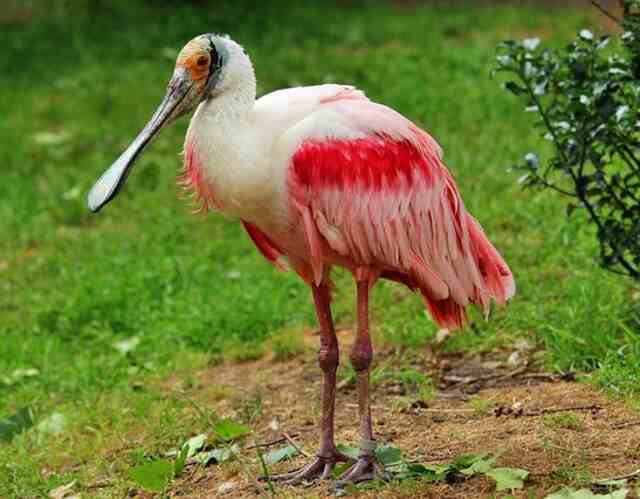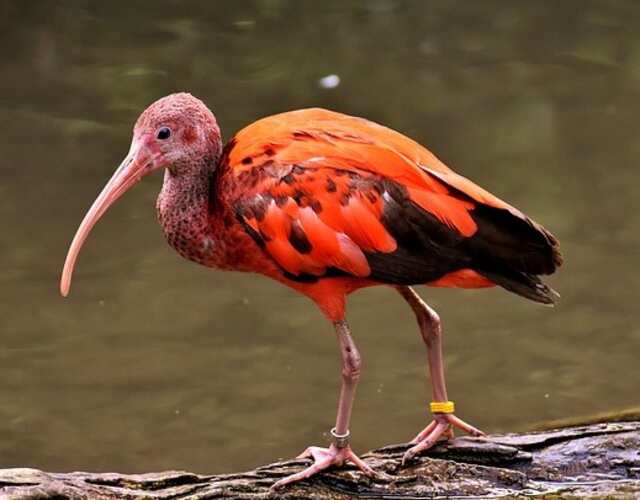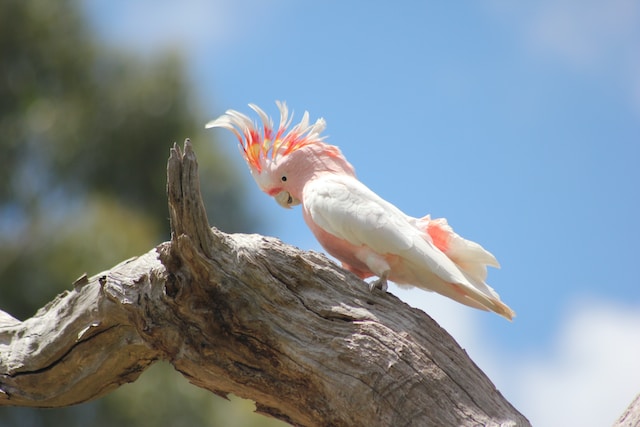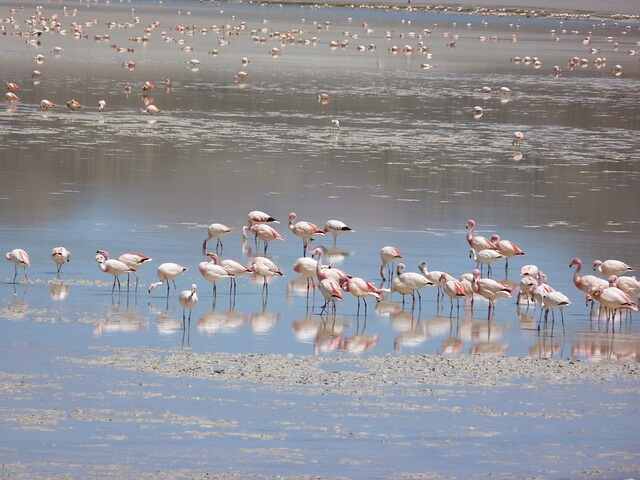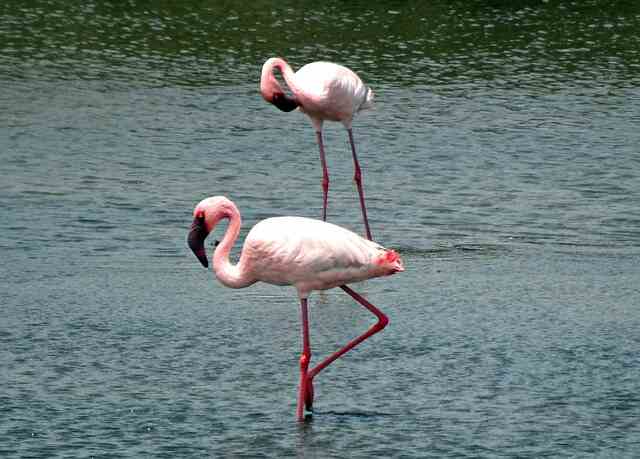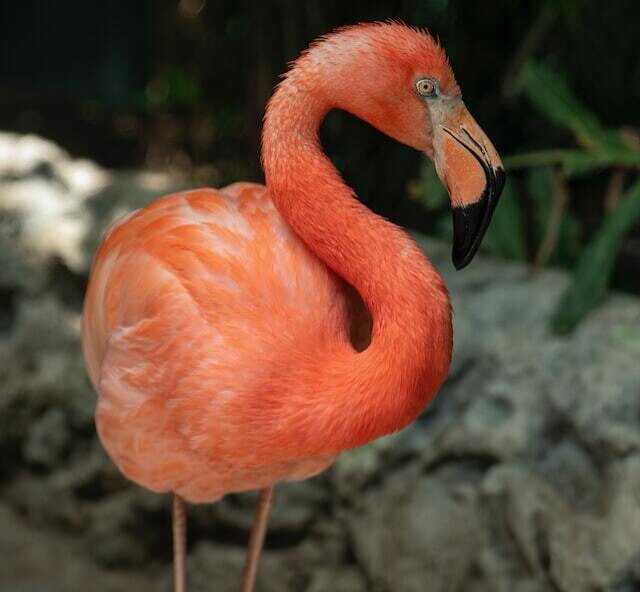When we think of birds, we often imagine them in shades of brown, gray, and black. However, nature has a way of surprising us with its vibrant coloration and stunning beauty. One such example is the pink bird, a striking avian species with a unique and distinctive appearance.
While the color pink is often associated with femininity and sweetness, pink birds are anything but delicate. They come in a range of shades, from soft pastels to vivid fuchsias, and can be found in various habitats around the world.
In this article, we will explore some of the most fascinating and beautiful pink birds and learn what makes them so special.
Table of Contents
- 1 Key Takeaways:
- 2 What Birds Are Pink?
- 3 The Flamingo: Iconic Pink Avian Beauty
- 4 Roseate Spoonbill: Pink Elegance in Wetlands
- 5 Scarlet Ibis: A Splash of Vibrant Pink in Tropical Forests
- 6 Pink Pigeon: A Rare Gem of Mauritius
- 7 Pink Cockatoo: Majestic Pink Parrots
- 8 Pink Robin: Delicate Beauty of the Australian Forests
- 9 Andean Flamingo: Graceful Pink Birds of the High Andes
- 10 Pink-backed Pelican: Subtle Pink Tones in Africa
- 11 Lesser Flamingo: Pink Flocks in African Lakes
- 12 American Flamingo: Vibrant Pink Waders of the Americas
- 13 The Beauty and Diversity of Pink Birds
- 14 FAQs: What Birds Are Pink?
- 15 Author
Key Takeaways:
- Pink birds are a unique and stunning addition to the avian world.
- They come in a range of shades and can be found in various habitats around the world.
- In this article, we will explore some of the most fascinating and beautiful pink birds.
What Birds Are Pink?
Flamingos are the most well-known pink birds, but there are other species that have pink feathers too. These include Roseate Spoonbills, Scarlet Ibises, Pink Pigeon, Pink Robin and some species of Parrots.
The Flamingo: Iconic Pink Avian Beauty
Among the most well-known and recognizable pink feathered birds is the flamingo. These graceful creatures are renowned for their incredible beauty and have become an enduring symbol of the natural world’s vibrant colors.
Flamingos are found in many parts of the world, from South America to Africa, and even in parts of Europe and Asia. They typically live in large colonies in wetland habitats, gathering in groups of hundreds or even thousands.
Their iconic pink plumage is caused by pigments in the algae and crustaceans they consume. When they are born, flamingos are actually gray or white, but over time their feathers turn pink as they consume more of these pigmented foods.
Physical Characteristics
Flamingos have a unique physiology that allows them to survive in their wetland habitats. Their long, slender legs and webbed feet help them walk on soft mud without sinking, while their long necks and specialized beaks allow them to feed on crustaceans and other small animals in the water.
In addition to their distinctive pink coloration, flamingos also have a pronounced curved beak that they use to filter small organisms from water. They are also known for their unique feeding behavior, in which they hold their heads upside down in the water to sift out their food.
Habitat and Diet
As mentioned, flamingos are typically found in wetland habitats such as lagoons, estuaries, and salt pans. They feed on a variety of small crustaceans, insects, and other aquatic organisms, which they sift from the water using their specialized beaks.
Although they are able to fly, flamingos are not strong fliers and typically only travel short distances between feeding and breeding sites. They are also known for their elaborate courtship displays, during which they perform synchronized dances and displays that are truly a sight to behold.
“Flamingos are true ambassadors of the natural world’s vibrant colors and are a testament to the incredible beauty and diversity of the avian species.”
Overall, flamingos are an iconic and beloved species of pink feathered birds, known for their stunning beauty and unique physical adaptations. Their presence in wetland habitats is an important part of the natural ecosystem, and they serve as an enduring reminder of the incredible beauty and diversity of the world’s avian species.
Roseate Spoonbill: Pink Elegance in Wetlands
The Roseate spoonbill is a striking bird species known for its vibrant pink coloration. These elegant birds are found in wetland habitats across the Americas, including the Gulf Coast states, the Caribbean, and parts of South America. Their unique appearance has earned them nicknames such as “flamenco” and “pink stork.”
| Physical Characteristics | Habitat and Distribution |
|---|---|
| Roseate spoonbills have long, thin legs and a wingspan of up to 50 inches. They are easily identified by their pink feathers, which range from pale pink to bright magenta. Their bills are spoon-shaped, hence their name, and are used to filter food from the water. | These birds are typically found in shallow wetlands such as marshes, swamps, and lagoons. They are most commonly found in the southern United States and the Caribbean, but can also be found in parts of Central and South America. |
Roseate spoonbills are opportunistic feeders, consuming a diet of fish, crustaceans, and other small aquatic animals. They use their specialized bills to sift through mud and water to find food. During breeding season, these birds build nests in trees or shrubs near water and form large breeding colonies with other wading bird species.
Conservation Status
The roseate spoonbill was heavily hunted for its feathers in the early 20th century, leading to a sharp decline in population numbers. Today, its biggest threats include habitat loss and degradation, pollution, and disturbance from human activity.
Despite these challenges, conservation efforts have helped to stabilize populations in some areas, and the bird is now listed as a species of least concern by the International Union for Conservation of Nature (IUCN).
Scarlet Ibis: A Splash of Vibrant Pink in Tropical Forests
The Scarlet ibis is a stunning bird with vivid pink plumage found in tropical forests. Their coloration is the result of their diet, which is rich in carotenoids. These pigments are responsible for the pink and orange hues seen in the feathers of many bird species.
Scarlet ibises are social birds that live in large flocks. They are known to form nesting colonies in trees and bushes, where they build their nests using twigs and leaves.
| Diet | Social Behavior | Breeding Habits |
|---|---|---|
| Crustaceans, mollusks, and insects | Large flocks that live in nesting colonies | Mating pairs build nests using twigs and leaves |
Scarlet ibises are found in tropical forests and wetlands throughout South America, particularly in Venezuela, Guyana, and Brazil. They are also known to inhabit the islands of Trinidad and Tobago.
Unfortunately, the population of scarlet ibises has been declining due to habitat loss and hunting pressure. Conservation efforts are in place to protect this stunning bird species and ensure its survival for generations to come.
Pink Pigeon: A Rare Gem of Mauritius
The Pink pigeon, also known as the Mauritius pink pigeon, is a rare and endangered bird species that is native to the island of Mauritius. With its beautiful pink plumage and unique characteristics, the pink pigeon is a true gem of the avian world.
The pink pigeon is a medium-sized bird that can grow up to 35 cm in length. The males have a more vibrant pink coloration compared to females, which have a more subdued pinkish-grey color.
Historically, the pink pigeon was widespread throughout Mauritius, but due to habitat destruction and introduction of non-native predators, their population declined dramatically.
In the late 20th century, conservation efforts were put in place to save this species from extinction. As a result, their population has increased, but they are still listed as endangered.
| Diet | Nesting Behavior | Conservation Status |
|---|---|---|
| The pink pigeon feeds primarily on fruits, seeds, and small insects. | The pink pigeon builds its nest in the forks of trees and lays one or two eggs at a time. Both parents take turns incubating the eggs and caring for the chicks. | Although the population of pink pigeon has increased, the species is still classified as endangered. Conservation efforts, including habitat restoration and predator control, continue to be implemented to ensure the survival of this unique bird species. |
The pink pigeon is an important part of the Mauritian culture and habitat, and its conservation efforts serve as an example of successful wildlife management and preservation.
Pink Cockatoo: Majestic Pink Parrots
The Pink cockatoo, also known as Major Mitchell’s cockatoo, is a stunning parrot species with vibrant pink plumage. These birds are native to Australia and are named after Sir Thomas Mitchell, an early Australian explorer and surveyor.
These majestic birds often have white feathers on their wings and crest, with splashes of bright pink on their head, neck, and body. Their beaks are curved and strong, perfect for cracking open tough seeds and nuts.
Habitat
Pink cockatoos are found in the arid and semi-arid regions of Australia, particularly in the interior lowlands. They prefer habitats with sparse vegetation and dry forests, but can also be found in acacia woodlands and drier eucalyptus forests. They are known to gather in large flocks during the dry season when food is scarce.
Behavior
Pink cockatoos are social birds and are often seen in pairs or small groups. They are known for their playful and curious nature, and are considered intelligent birds. They communicate with each other through a variety of calls and whistles, and are able to mimic human speech.
During breeding season, males perform a complex courtship display to attract females. This includes fluffing up their feathers, bowing and bobbing their head, and making loud calls to impress potential mates. Once a female has chosen a mate, they will work together to build a nest in a tree cavity or a hollow log.
Conservation
The pink cockatoo is considered a vulnerable species due to habitat loss and illegal capture for the pet trade. Efforts are being made to protect their natural habitats and regulate the trade of captive birds. Breeding programs have also been established to increase their population numbers and preserve genetic diversity.
The beauty and uniqueness of the pink cockatoo make it a beloved species among bird enthusiasts and nature lovers. It serves as a reminder of the importance of conservation efforts to protect such remarkable creatures.
Pink Robin: Delicate Beauty of the Australian Forests
The Pink robin (Petroica rodinogaster) is a small songbird found in the forests of southeastern Australia. Despite their name, only the male birds have a pink-colored breast, while the females are gray-brown in coloration. The distinctive coloration of the male pink robin serves as a signal of their quality as a mate, and helps them attract a female during breeding season.
These birds are insectivores, feeding on a variety of invertebrates such as beetles, spiders, and ants. They are territorial and often forage alone or in pairs. During breeding season, their nests are built in tree hollows or crevices, and are lined with soft materials such as moss or fur.
While not considered endangered, the pink robin faces threats from habitat loss due to deforestation and altered fire regimes. Conservation efforts such as the protection of their habitat and control of invasive species are crucial for the survival of this delicate beauty of the Australian forests.
Andean Flamingo: Graceful Pink Birds of the High Andes
The Andean flamingo is a beautiful bird species that is native to the high-altitude Andean lakes of South America. They are known for their elegant and graceful appearance, with long, slim legs and a distinctive pink coloration that sets them apart from other flamingo species.
The Andean flamingo is the only flamingo species that has yellow legs, giving them a unique and striking appearance. They also have distinctive black and white markings on their wings, which are visible when they are in flight.
These birds are adapted to living in the harsh conditions of the Andean mountains, where they can be found in lakes that are over 4,500 meters above sea level. They have physiological adaptations that allow them to survive in such high altitudes, such as specialized lung structures that allow them to extract oxygen more efficiently from the thin air.
Physical Features
One of the most striking features of the Andean flamingo is their pink plumage. The color of their feathers is due to the carotenoid pigments in the algae and small crustaceans that they feed on. Their necks and legs are a deeper pink than the rest of their bodies, which gives them a striking appearance.
The Andean flamingo is a medium-sized bird, measuring up to 110 centimeters in length and weighing up to 4 kilograms. They have a long, thin neck and a slender body, with wingspans of up to 150 centimeters.
Feeding Behavior
Andean flamingos are filter feeders, which means that they use their specialized beaks to filter food from the water. They feed on algae, diatoms, and small crustaceans that they find in the shallow waters of the Andean lakes.
The Andean flamingo has a unique feeding behavior where they move their beaks back and forth through the water while walking along the lakebed. This allows them to stir up the mud and silt and filter out the small organisms that they feed on.
Conservation Status
The Andean flamingo is classified as a species of “Least Concern” by the International Union for Conservation of Nature (IUCN). However, their populations have been declining due to habitat loss, hunting, and disturbances from human activities.
Conservation efforts are underway to protect Andean flamingos and their habitats. In Chile and Argentina, Andean flamingo reserves have been established to protect their breeding grounds. These reserves also provide education and awareness programs to local communities to reduce the impact of human activities on the birds.
Pink-backed Pelican: Subtle Pink Tones in Africa
The Pink-backed pelican is a large waterbird species found in various parts of Africa. Known for its subtle pink hues, this bird’s striking appearance makes it a popular sight among birdwatchers and nature enthusiasts.
While the pink-backed pelican is not as vibrantly colored as some other pink bird species, its pink feathers add a unique touch to its overall appearance. The bird’s plumage is primarily gray and white, with subtle pink tones on the back and sides of its neck.
Pink-backed pelicans are social creatures, often seen in large groups that can number in the hundreds. These birds are also great fishermen, frequently diving into water bodies to catch fish and other small aquatic animals. Their large beaks can hold up to 11 liters of water, allowing them to scoop up large amounts of fish in one go.
Pink-backed pelicans typically nest in large colonies in trees near shallow wetlands. These wetlands serve as their primary breeding grounds and provide them with ample food resources. However, these habitats are under increasing threat due to human activities such as deforestation and pollution.
| Conservation Status | Threats to the Pink-backed Pelican |
|---|---|
| The pink-backed pelican is classified as ‘Least Concern’ on the IUCN Red List. | The primary threat to the pink-backed pelican is habitat loss due to human activities. Wetland degradation and deforestation, which affect the bird’s nesting and feeding grounds, are the major threats. Other threats include hunting, egg collection, and pollution. |
To ensure the survival of the pink-backed pelican, conservation efforts must be stepped up to protect the wetland habitats that house these birds. Governments, NGOs, and other stakeholders must work together to promote sustainable land use practices and reduce pollution of water bodies. Public education campaigns can also help raise awareness about the importance of wetlands and the need to protect them.
Lesser Flamingo: Pink Flocks in African Lakes
The Lesser flamingo, another avian species with striking pink feathers, is known for its large flocks that color African lakes. These birds are often seen wading through shallow waters to feed on algae and other small aquatic organisms. Their unique feeding behavior involves sieving water through specialized bristle-like structures in their beaks. The lesser flamingo is also notable for its unusual leg joints, allowing it to stand for long periods of time in water.
Conservationists are concerned about the declining population of lesser flamingos, due to habitat loss and changes in water chemistry. The birds are particularly sensitive to pollution and are affected by the diversion of fresh water sources for human use. Efforts are underway to protect and restore the habitats of these beautiful birds, as they are an important part of the diverse African ecosystem.
American Flamingo: Vibrant Pink Waders of the Americas
The American flamingo, also known as the Caribbean flamingo, is a striking bird species found in parts of North, Central, and South America. These wading birds are known for their vibrant pink plumage, which is actually a result of their diet.
American flamingos feed on algae, small crustaceans, and other invertebrates found in the shallow waters of lagoons, estuaries, and tidal flats. These foods contain pigments called carotenoids, which give the flamingos’ feathers their iconic pink hue. The more carotenoids a flamingo consumes, the brighter its feathers become.
American flamingos are social birds, often found in flocks of hundreds or even thousands of individuals. They build their nests out of mud, often in large colonies, and both parents take turns incubating the eggs and caring for the chicks. These birds are also known for their distinctive feeding behavior, where they filter water through their uniquely shaped bills to capture small organisms.
American flamingos are migratory birds, traveling long distances to find suitable feeding and nesting grounds. Some populations can be found in the Florida Keys, Mexico, the Caribbean, and northern South America. These birds are also threatened by habitat loss and pollution, making conservation efforts crucial to their survival.
The Beauty and Diversity of Pink Birds
Pink birds are a unique and vibrant group of avian species found across the world. From the iconic flamingo to the delicate pink robin, these birds exhibit a wide range of physical adaptations and behaviors that make them fascinating natural wonders.
Despite their vivid coloration, pink birds face numerous threats to their survival. Habitat loss, pollution, and hunting are just a few of the challenges that these birds face on a daily basis. As such, conservation efforts are crucial to ensure their continued existence in the wild.
The Importance of Pink Birds in the Natural World
Pink birds play an important role in the ecosystems in which they live. As predators and prey, pollinators and seed dispersers, these birds contribute to the maintenance of biodiversity and the health of their local environments. They are also valuable indicators of environmental health and the impacts of human activities on natural systems.
The Future of Pink Birds
As humans continue to encroach on natural habitats and alter the planet’s ecosystems, pink birds face increasing pressures and challenges. However, with dedicated conservation efforts and public awareness campaigns, we can work towards a future where pink birds and other species can thrive in healthy, vibrant environments.
The beauty and diversity of pink birds serve as a reminder of the incredible wonders of the natural world and the importance of protecting and preserving these precious resources for future generations to enjoy and appreciate.
FAQs: What Birds Are Pink?
What is the significance of pink coloration in birds?
Pink coloration in birds is often a result of pigments called carotenoids, which they obtain from their diet. It can serve various purposes, including attracting mates, signaling social status, and providing camouflage in certain habitats. Pink feathers can also be an indicator of good health and nutrition.
Are all pink birds the same species?
No, there are multiple species of birds that exhibit pink coloration. Some well-known examples include flamingos, roseate spoonbills, scarlet ibis, and pink pigeons. Each species has its own unique characteristics and habitat preferences.
Where can pink birds be found?
Pink birds can be found in different parts of the world, depending on the species. Flamingos, for instance, are commonly found in areas with saltwater or alkaline lakes, such as Africa, the Americas, and parts of Europe and Asia. Other pink birds may be found in wetland habitats, tropical forests, or specific islands.
Are all pink birds endangered?
While some pink bird species, such as the pink pigeon and Andean flamingo, are considered endangered, not all pink birds face the same conservation status. Some species, like the American flamingo, have stable populations and are not considered endangered. However, habitat loss, pollution, and climate change remain threats to many bird species, including those with pink plumage.
Can pink birds fly?
Yes, pink birds, including flamingos and roseate spoonbills, are capable of flight. Their long legs and necks, which contribute to their unique appearance, are adaptations for their specific habitats and feeding behaviors.
Do pink birds have any predators?
Pink birds, like any other bird species, can have predators depending on their habitats and locations. Some potential predators may include large birds of prey, such as eagles or hawks, as well as certain mammals that feed on birds or their eggs.

